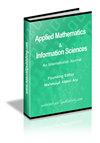{"title":"Estimating Parameters of a SEIRD Model Applied to SARS-CoV-2 Infections in Germany based on the Particle Swarm Optimization Method","authors":"E. A. Nakajima, A. Ignacio, D. Lange, E. Izumi","doi":"10.18576/amis/150403","DOIUrl":null,"url":null,"abstract":"The present paper describes a particle swarm optimization (PSO) method used to estimate parameters of a Susceptible-Exposed-Infected-Recovered-Dead (SEIRD) model applied to predict SARS-CoV-2 transmission in Germany, based on data from February 15th to April 25th, 2020, considering that the lockdown in the country started on March 23rd. The model estimated patients' mortality (4.92%) and recovery rates (95.08%), virus incubation (8.54 days), infection periods (18.65 days), as well as the basic virus reproduction number before (R0 = 11.60) and after (R0 = 0.39) lockdown. The predicted values were accurate until the 70th day. The performances achieved by the model were 0.98 for infected, 0.97 for the recovered and 0.97 for the dead, asserting the model's great performance (>0.75). The model also suggests that on February 15th, 2020, there were 67 infected individuals in the incubation period. We believe that this model can help other studies to better understand and accurately predict epidemic curves, mainly in countries where the new coronavirus has recently started to spread. It also may guide public health policies that aim to control the disease. © 2021 NSP Natural Sciences Publishing Cor. All Rights Reserved.","PeriodicalId":49266,"journal":{"name":"Applied Mathematics & Information Sciences","volume":" ","pages":""},"PeriodicalIF":0.0000,"publicationDate":"2021-07-01","publicationTypes":"Journal Article","fieldsOfStudy":null,"isOpenAccess":false,"openAccessPdf":"","citationCount":"1","resultStr":null,"platform":"Semanticscholar","paperid":null,"PeriodicalName":"Applied Mathematics & Information Sciences","FirstCategoryId":"1085","ListUrlMain":"https://doi.org/10.18576/amis/150403","RegionNum":0,"RegionCategory":null,"ArticlePicture":[],"TitleCN":null,"AbstractTextCN":null,"PMCID":null,"EPubDate":"","PubModel":"","JCR":"Q2","JCRName":"Mathematics","Score":null,"Total":0}
引用次数: 1
基于粒子群优化方法的德国SARS-CoV-2感染SEIRD模型参数估计
本文描述了一种粒子群优化(PSO)方法,用于估计用于预测德国SARS-CoV-2传播的易感-暴露-感染-恢复-死亡(SEIRD)模型的参数,该模型基于2020年2月15日至4月25日的数据,考虑到德国的封锁始于3月23日。该模型估计了封锁前(R0 = 11.60)和封锁后(R0 = 0.39)患者的死亡率(4.92%)和康复率(95.08%)、病毒潜伏期(8.54天)、感染期(18.65天)以及基本病毒繁殖数。在第70天之前,预测值是准确的。模型对感染、恢复和死亡的性能分别为0.98、0.97和0.97,表明该模型具有良好的性能(>0.75)。该模型还显示,2020年2月15日,有67名感染者处于潜伏期。我们相信这个模型可以帮助其他研究更好地理解和准确预测流行曲线,主要是在新冠病毒最近开始传播的国家。它还可以指导旨在控制这种疾病的公共卫生政策。©2021 NSP自然科学出版社版权所有
本文章由计算机程序翻译,如有差异,请以英文原文为准。


